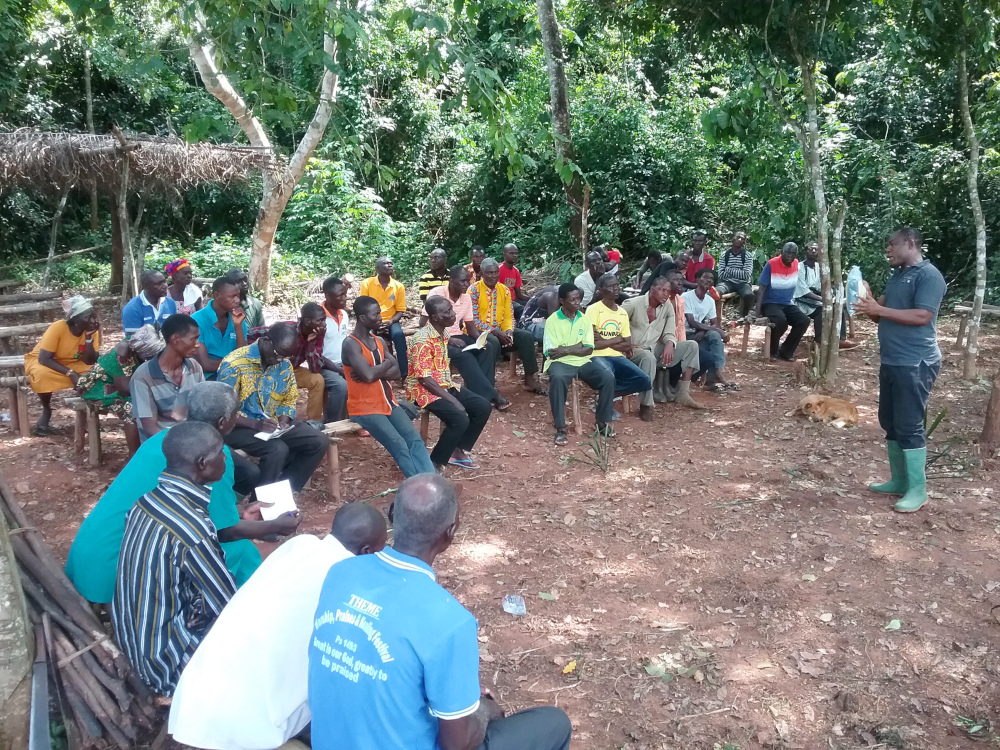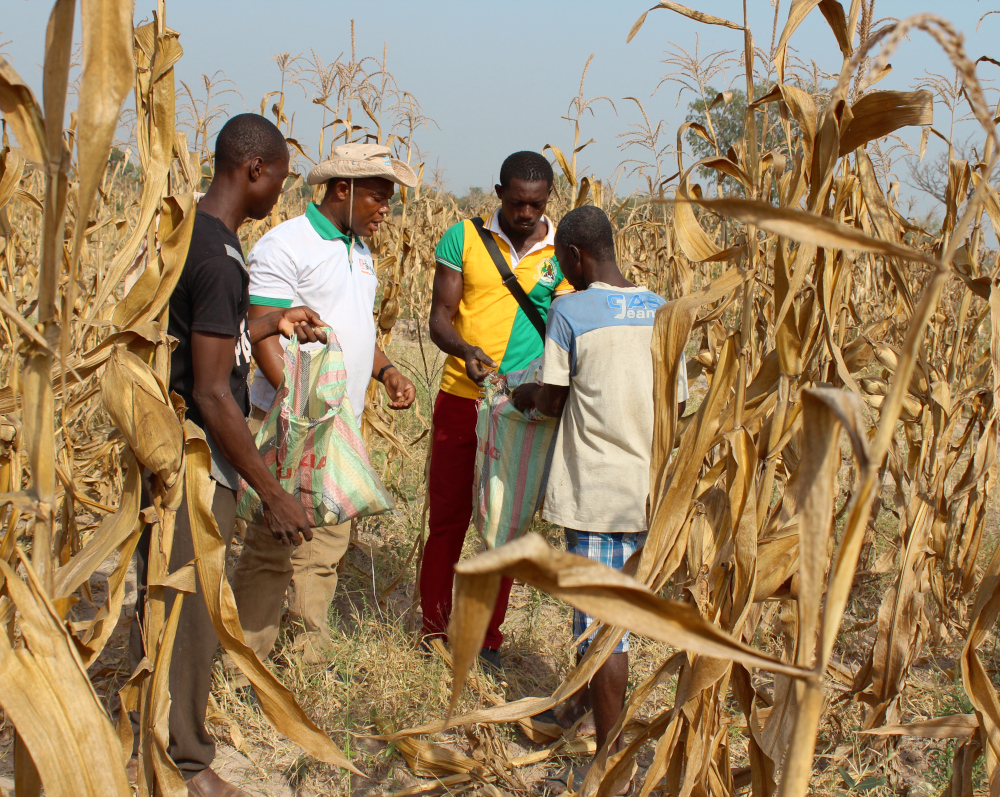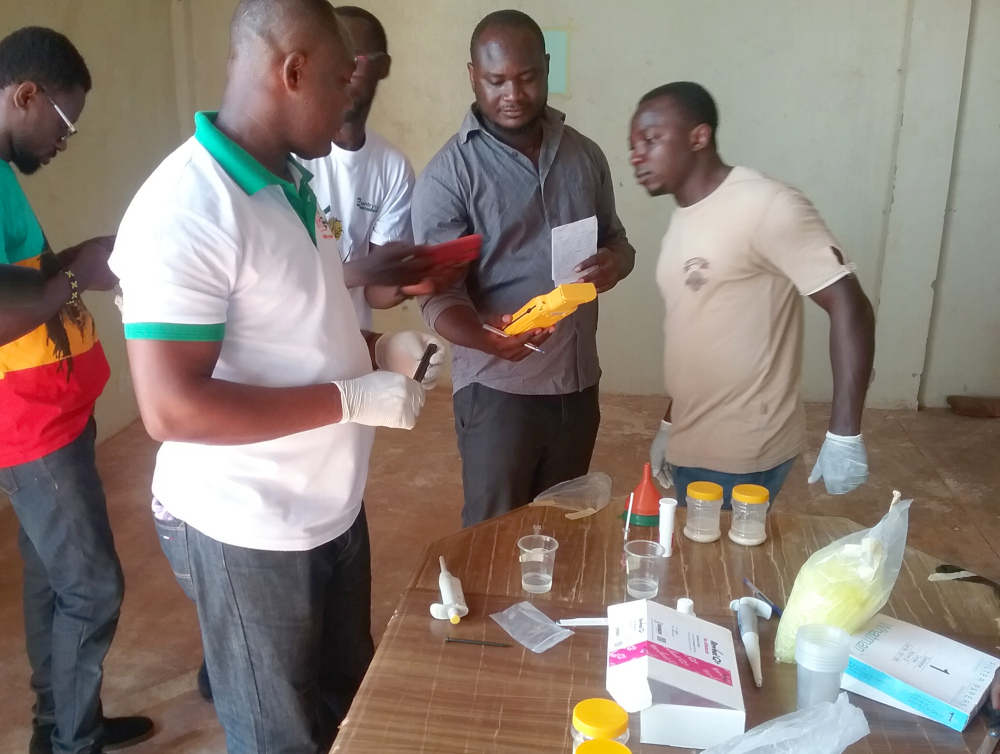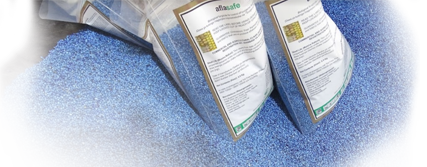In the fight against aflatoxin, knowledge is our greatest power. Farmers, and all those who help them to supply Ghana’s food, need to know about the threat of contamination and how to beat it with Aflasafe. Expanding partnerships with development organisations, as well as agribusinesses and farmer groups, are helping us to reach more stakeholders and create a groundswell of Aflasafe demand for the future. Field demonstrations show Aflasafe GH02 in action, with aflatoxin testing now returning convincing proof of its power to make food aflatoxin-safe.

Participatory, farmer-managed demonstrations are an indispensable tool for building awareness of aflatoxin and Aflasafe on the ground. We are continuing to support our distribution partner in Ghana, Macrofertil Ghana Ltd, in setting up and monitoring demonstrations and in seeking partnerships to magnify our impact.
Thus, in October 2018, Macrofertil worked with GIZ’s Green Innovation Centre (GIC) to set up demonstrations in collaboration with local farmers’ organisations supported by GIC in Eastern Region – a new region for Aflasafe, extending our geographical reach and coverage – as well as four in Brong Ahafo Region. In Brong Ahafo, we also set up a further seven demonstrations in partnership with agribusinesses identified through the Regional Department of Agriculture, as well as one in Ashanti, another new region. Coming hot on the heels of our earlier demonstrations in Ghana’s three northern regions and in Brong Ahafo, this took the total number of Aflasafe demonstrations in maize, groundnuts and sorghum across the country to 38.

By working with development partners like GIC, we are successfully and efficiently reaching more people and catalysing a sustainable, demand-driven future for Aflasafe GH02. We have also been aided enormously by our partnerships with the Ministry of Food and Agriculture at the national, regional and district levels in helping us to find the right agribusinesses and farmer groups to work with. Our partners have the on-the-ground connections to bring groups of farmers together, often leaders within their communities, and they themselves get training in Aflasafe so that they can go on to become trainers of many more farmers. For example, in our Eastern Region demonstration, at Nsutam near Koforidua, there were 39 participants drawn from seven different farmer groups supported by the GIC, as well as the public and private sectors.
At each demonstration, a farmer’s field is treated with Aflasafe GH02, while a corresponding field (separated by a buffer zone) is left untreated for comparison. While farmers are our key participants, others come from government and agricultural extension, development organisation partners, agribusiness and agro-dealerships, and the food industry.
Demonstrations like these mean budding Aflasafe champions verify the performance of Aflasafe GH02 for themselves, as well as getting very a practical grounding in how to use it. Testing for aflatoxin levels is a crucial part of the demonstration process, providing concrete evidence of the power of Aflasafe. Knowledge is a two-way street, however. Although Aflasafe GH02’s effectiveness has already been thoroughly proven during development and registration, these extra data give us more detail on levels of aflatoxin contamination around the country and how Aflasafe GH02 performs under different conditions, as well as helping us fine-tune our training to our customers’ needs. In November and December it was therefore time for follow-up visits to the demonstrations to carry on discussions and training with participants, take samples, and conduct aflatoxin tests before an eager audience.

So how did Aflasafe perform when put through its paces in the real world? “If you look at the maize field that we applied the Aflasafe on, we were told the aflatoxin levels should not be more than 15 ppb. Based on the test we have conducted today, the result is very good. It is 1.7 ppb! This shows that Aflasafe has worked,” said Mr Aliyu Yakubu, Assistant Operations Manager at agribusiness Amsig Resources Limited. “So, to get low aflatoxin levels, it means that we should use Aflasafe. The health of anyone who eats maize and groundnuts will be safe.”
Aflatoxin contamination was slashed in crops from Aflasafe GH02-treated fields: Aflasafe-protected maize and groundnuts contained between 88 to 94% less aflatoxin. In maize, aflatoxin was 2.1 ppb on average from Aflasafe-treated fields, well below the safe limit of 15 ppb set by the Ghana Standards Authority (GSA) – and even the strict European Union level of 4 ppb, meaning that it could be exported to Europe. In contrast, the average aflatoxin level in maize from non-treated (control) fields was 17.6 ppb, exceeding the GSA limit. Similarly, average aflatoxin for Aflasafe-treated groundnuts was 1.5 ppb compared to a dangerous 27.3 ppb in control fields (against a GSA limit of 20 ppb).
But Aflasafe alone is not a magic bullet: good agricultural practices also count and are a must. Crop handling and storage are particularly crucial. We found that after only seven days in poor storage, aflatoxin contamination could shoot up, to an average of 54.6 ppb compared with 6.2 ppb for Aflasafe-treated maize. A small number of untreated samples taken from farmers’ own stores, that they had been keeping for sale or home use, showed even worse contamination, with well over 100 ppb of aflatoxin in four out of five cases.
Only in sorghum did the results not show a clear pattern. These demonstration plots were all close to houses, with domestic chicken and guinea fowl wandering freely. In routine checks a few days after application, the blue-dyed sorghum grains used as the vehicle for Aflasafe were nowhere to be seen, so it seems likely that they were eaten before they could work their magic. This is just the kind of problem that real-world demonstrations can bring to light, and one that we will work with farmers to solve.

Having seen for themselves what Aflasafe can do, farmers are keen to purchase it: “I am urging that those who are in charge of the distribution of Aflasafe make it accessible to us,” said Fati Ajubala, a participating farmer from Bui Kodima in the Upper East region.
While our real-world results are throwing up challenges and as we learn to adapt our approach, Aflasafe GH02’s spread across Ghana seems unstoppable as Macrofertil works to ensure that the product is available to buyers, while our partner organisations and farmer leaders continue to share the knowledge of Aflasafe with more and more farmers in ever-expanding ripples. We will also be reaching additional communities with further demonstrations planned for 2019. We look forward to supporting our local Aflasafe champions throughout the year, and to watching their numbers blossom.
We captured some of the action during the aflatoxin testing on video. So, watch this space for yet more evidence in the next quarter on how Aflasafe is being received and perceived by our end-users – farmers and development agencies.
LINKS
- More on how we’re reaching out to movers and shakers: Aflatoxin awareness and forming Aflasafe leaders: ‘royal’ approval from market queens in Ghana
- More on government leadership at national level: Fighting aflatoxin with top-level leadership: new national steering committee for Ghana
- The latest on Aflasafe communications to support commercialisation, including new videos for Ghana: Breaking ground on the silver screen with Aflasafe communications
- Previous news items from us:
- Ghana’s grit, hard graft and great strides in aflatoxin awareness and Aflasafe GH02 partnerships
- Getting to grips with aflatoxin in Ghana – Aflasafe GH02 launched, bags gold
- Ghana’s growing and glowing gallery of collaborators to combat aflatoxin in food with Aflasafe GH02
- Aflasafe GH02 now registered in Ghana to protect maize and groundnuts from deadly aflatoxin
- Keep updated on the latest on Aflasafe in Ghana










